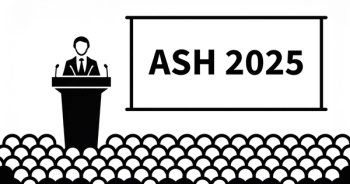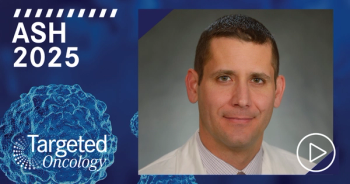
CRS and ICANS Show Low Severity With Bispecifics in Multiple Myeloma
Douglas Sborov, MD, discusses adverse events in the MajesTEC-1 study of teclistamab in multiple myeloma.
Targeted OncologyTM: What adverse events (AEs) were of interest in the MajesTEC-1 study (NCT03145181/NCT04557098) of teclistamab (Tecvayli) in patients with relapsed/refractory multiple myeloma?
Douglas W. Sborov, MD, MS: The majority of patients had cytokine release syndrome [CRS]. CRS is systemic inflammatory response. What we see with ICANS [immune effector cell–associated neurotoxicity syndrome] is an inflammatory response in the central nervous system. The majority of patients get that systemic inflammatory response, but very few, in this case [only] 1, had a grade 3 event.1
When we look at neurotoxicity, the majority of patients, if they're going to get any kind of neurotoxicity, they get a headache. It's very responsive to dexamethasone. When we're thinking about tocilizumab [Actemra] and dexamethasone, these are 2 very effective ways at tampering down this inflammatory response. Tocilizumab doesn't cross the blood-brain barrier. If we're dealing with somebody who has a higher-grade CRS, we use tocilizumab. The half-life is long, and it tampers down the systemic inflammation in a major way. But patients can still have these neurologic problems because the tocilizumab is not crossing the blood-brain barrier. In those patients, we use dexamethasone, or methylprednisone if we're getting into trouble, but that's mostly going to be in your patients [receiving] chimeric antigen receptor [CAR] T-cell therapy.
It's important to appreciate the fact these trials were all run during the COVID-19 pandemic. These patients get viral infections [continuously]. You check for rhinovirus, and they are positive for months at a time. We used to think, it’s working, and we don't know what happens if we stop it. Now that we figured out that we can stop it safely, instead of patients being miserable and having a cold for a year and a half, we stop the drug, let them recover, and then restart the drug again. Those infections are a real problem.
When do CRS and ICANS occur in patients receiving bispecific antibodies?
We talked about 71% CRS; grade 1 [was 50%], grade 2 [was 21%], and only 1 patient had a grade 3 event.2 When you look at when it's happening, it's happening in those step-up doses. Day 1 [in 43%], day 3 [in 35%], day 5 [in 24%]. It's in that ramp up period. Most of the patients are getting it with dose 1.
How does the severity of CRS compare with that seen with CAR T-cell therapy?
For the majority of patients, it is grade 1 and 2 in myeloma. It's different than lymphoma. Lymphoma seems to be higher grade, but [in myeloma] it is probably 5% grade 3 or higher. It is not a lot of patients, but some of these patients can really activate. What we tend to see in patients with myeloma who are getting CAR T who have worse CRS, is that you'll have the persistence of a lower-grade CRS event. Part of that might be that we're stepping in earlier. We used to [believe] we wouldn’t get responses unless we let people get sick. Now as soon as somebody gets a CRS grade 1, we can step in with tocilizumab, calm the system down, and [know] it’s not affecting response. But in general, we do not see high-grade events with myeloma like we saw with lymphoma.
What is the time of onset and resolution for CRS and ICANS?
When you're dealing with the signal for CRS, you see it in step-up dosing, and then it goes away. When we are talking about when we should send people back to [community practice], some centers [say] 3 months [but I say] 10 days. My goal is to get people home. We just want to bring people in and get them ramped up and get them home.
With teclistamab, on average, [onset of CRS] is 2 days [range, 1-6], but it is in that first week duration.3 This is even shorter when we start talking about intervention with dexamethasone and tocilizumab. When we look at ICANS, it's happening after the CRS [median, 4 days; range, 2-8]. This is what we see with CAR T-cell therapy as well. For elranatamab [Elrexfio], we see it a little bit earlier.4 This is predictable; we see it within that first 24 to 36 hours. It lasts a little bit shorter period [than with teclistamab]. We see the ICANS after the CRS. Then with talquetamab [Talvey], it's very similar to what we saw with teclistamab.5 It's all within that ramp-up dosing.
Should you restart with step-up dosing after a dose interruption?
The idea is that the longer you wait, you should be going back to the step-up dosing. But you don't see the recurrent CRS signal. If you look at the label, the label has all of these recommendations.3 It gives you a table that says, if it's been 7 days, you can just restart. If it's 28 days or longer, then you should go back to the [day 1] dose.
What are the signs and symptoms of CRS?
When we look at CRS, it's very simple. For grade 1, it is a fever. For grade 2, it is a fever plus low oxygen requirement and/or need for fluids because of hypotension. When they start going up into grade 3, you start talking about using vasopressors and needing more oxygen. At grade 4, you get into some problems. Grade 3 and grade 4 are handled in the intensive care unit, but we've already covered that with bispecifics that we're [rarely] getting grade 3 and 4 events. What we're seeing is patients with fevers and a little bit of hypotension response of the fluids, and maybe need for a liter or 2 of oxygen and it's all very manageable.
DISCLOSURE: Sborov previously reported consulting or advisory role for Sanofi, GlaxoSmithKline, Bristol Myers Squibb, Legend Biotech, Janssen, Pfizer, Bioline, AstraZeneca, Arcellx and Abbvie. O.N reports consulting or advisory role with Bristol Myers Squibb, Janssen, Takeda, Sanofi, Pfizer, GPCR therapeutics, and research funding from Janssen and Takeda.








































